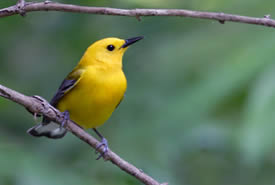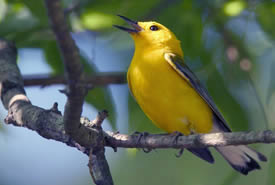Prothonotary Warbler

Prothonotary warbler (Photo by Bill Hubick)
Where is this species found?
In the summer months, prothonotary warblers nest and breed in wooded swamps in southwestern United States, up to the southwestern edge of Ontario.
These warblers make their summer homes in forests of tree species such as white oak, blackgum, willow and birch. All of these tree species can be found in Backus Woods — one of the last places in Canada that still supports a small population of breeding prothonotary warblers.
In the winter months, prothonotary warblers can be found in the mangrove forests of Central America, the Dominican Republic, Puerto Rico, Ecuador, Columbia, Venezuela and Guyana.
Where does this species live?
The prothonotary warbler is the only warbler that nests in small tree cavities. They make use of cavities that downy woodpeckers or black-capped chickadees have excavated. They will also occupy special nest boxes.
Prothonotary warblers make their nests mostly with moss. The males select the nest cavities and begin the nest building process by bringing moss to the cavity. Once the male attracts a mate, the females finish the nest building process using plant material such as mosses, liverworts, leaves, sedges and grasses. The tiny nests are only two inches wide!

Prothonotary Warbler (Photo by Bill Hubick)
What does this species eat?
Prothonotary warblers forage on bark for food and feed on insects such as:
- spiders
- flies
- beetles
- butterflies
- moths
Click below to hear the loud ringing tweet of the prothonotary warbler (courtesy of Bill Hubick.)
Supported by the Weston Family Foundation.




